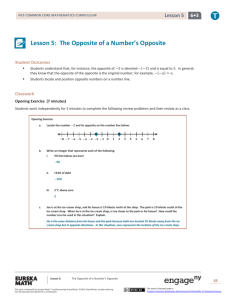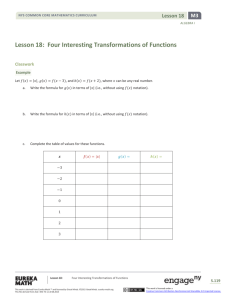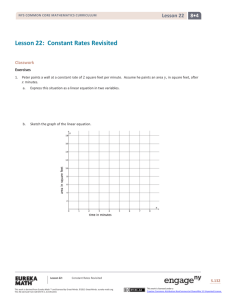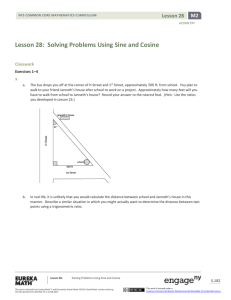Lesson 8: Why Stay with Whole Numbers?
advertisement
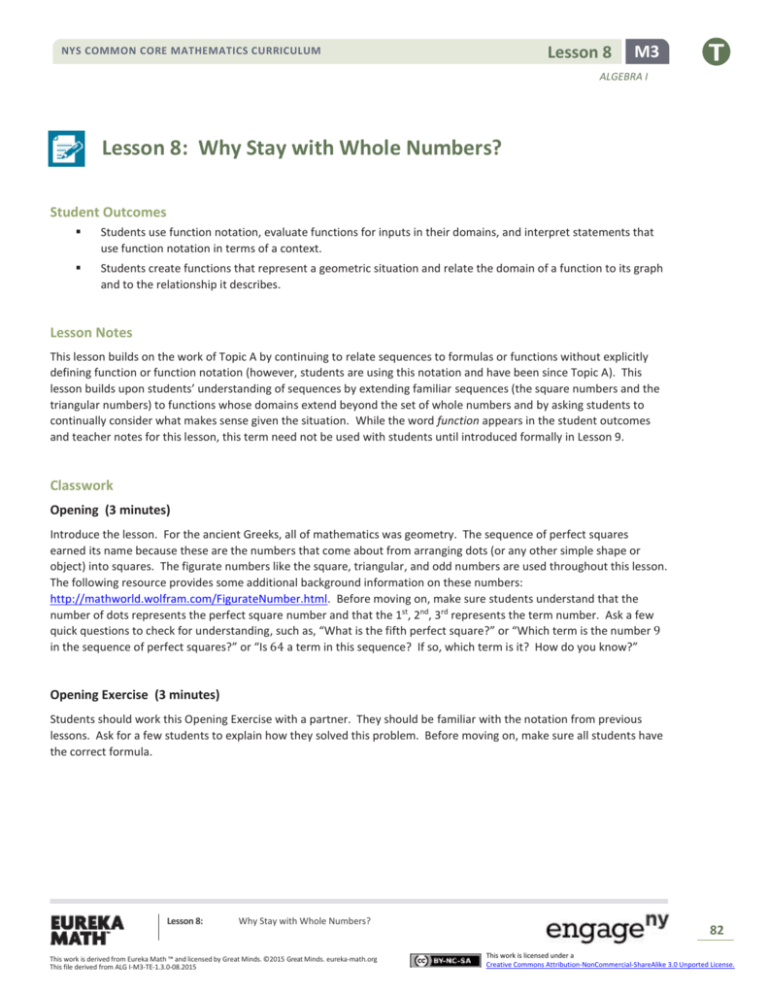
Lesson 8
NYS COMMON CORE MATHEMATICS CURRICULUM
M3
ALGEBRA I
Lesson 8: Why Stay with Whole Numbers?
Student Outcomes
Students use function notation, evaluate functions for inputs in their domains, and interpret statements that
use function notation in terms of a context.
Students create functions that represent a geometric situation and relate the domain of a function to its graph
and to the relationship it describes.
Lesson Notes
This lesson builds on the work of Topic A by continuing to relate sequences to formulas or functions without explicitly
defining function or function notation (however, students are using this notation and have been since Topic A). This
lesson builds upon students’ understanding of sequences by extending familiar sequences (the square numbers and the
triangular numbers) to functions whose domains extend beyond the set of whole numbers and by asking students to
continually consider what makes sense given the situation. While the word function appears in the student outcomes
and teacher notes for this lesson, this term need not be used with students until introduced formally in Lesson 9.
Classwork
Opening (3 minutes)
Introduce the lesson. For the ancient Greeks, all of mathematics was geometry. The sequence of perfect squares
earned its name because these are the numbers that come about from arranging dots (or any other simple shape or
object) into squares. The figurate numbers like the square, triangular, and odd numbers are used throughout this lesson.
The following resource provides some additional background information on these numbers:
http://mathworld.wolfram.com/FigurateNumber.html. Before moving on, make sure students understand that the
number of dots represents the perfect square number and that the 1st, 2nd, 3rd represents the term number. Ask a few
quick questions to check for understanding, such as, “What is the fifth perfect square?” or “Which term is the number 9
in the sequence of perfect squares?” or “Is 64 a term in this sequence? If so, which term is it? How do you know?”
Opening Exercise (3 minutes)
Students should work this Opening Exercise with a partner. They should be familiar with the notation from previous
lessons. Ask for a few students to explain how they solved this problem. Before moving on, make sure all students have
the correct formula.
Lesson 8:
Why Stay with Whole Numbers?
This work is derived from Eureka Math ™ and licensed by Great Minds. ©2015 Great Minds. eureka-math.org
This file derived from ALG I-M3-TE-1.3.0-08.2015
82
This work is licensed under a
Creative Commons Attribution-NonCommercial-ShareAlike 3.0 Unported License.
Lesson 8
NYS COMMON CORE MATHEMATICS CURRICULUM
M3
ALGEBRA I
Opening Exercise
The sequence of perfect squares {𝟏, 𝟒, 𝟗, 𝟏𝟔, 𝟐𝟓, … } earned its name because the ancient Greeks realized these quantities
could be arranged to form square shapes.
If 𝑺(𝒏) denotes the 𝒏th square number, what is a formula for 𝑺(𝒏)?
𝑺(𝒏) = 𝒏𝟐
Discussion (5 minutes)
Lead a discussion on the meaning of 𝑆(50), 𝑆(16), 𝑆(0), 𝑆(𝜋), 𝑆(2.35), etc. Lead the class to the result that while a
value can certainly be computed for 𝑆(𝜋) using the formula 𝑆(𝑛) = 𝑛2 , the values are only meaningful if the notion of a
square number is expanded to imagine a square with a fractional side length. When moving away from nonnegative
integer inputs however, the ordered set of 𝑆(𝑛) values for 𝑛 > 0 no longer forms a sequence according to the definition
of a sequence. In the next lesson, the concept of a function and its definition is introduced. An important point is that
the input value has meaning in a situation. Similarly, the output value must also be meaningful. The next exercise
introduces that idea.
In this situation, what does 𝑆(50) mean? What would this number look like?
In this situation, what does 𝑆(0) mean? 𝑆(𝜋)? 𝑆(2.35)?
It means the 50th square number. The value is 2,500. It would be a 50 row by 50 column arrangement
of dots.
Using the formula, 𝑆(0) = 0. In this situation, you cannot form a square with 0 dots or create a square
with sides of length 0 units. The others could be evaluated using the formula, and we would have to
alter our meaning of square numbers. Instead of an arrangement of dots, we could think of a square
number as the area of a square with a side measure of 𝑛 units. It would be difficult to represent these
numbers with arrangements of dots.
In this situation, what does 𝑆(−1) mean?
Using the formula, 𝑆(−1) = 1. Perhaps it would mean we constructed a square on the number line
whose side was the distance between the number 0 and the number −1.
Lesson 8:
Why Stay with Whole Numbers?
This work is derived from Eureka Math ™ and licensed by Great Minds. ©2015 Great Minds. eureka-math.org
This file derived from ALG I-M3-TE-1.3.0-08.2015
83
This work is licensed under a
Creative Commons Attribution-NonCommercial-ShareAlike 3.0 Unported License.
Lesson 8
NYS COMMON CORE MATHEMATICS CURRICULUM
M3
ALGEBRA I
Exercises 1–11 (18 minutes)
In this exercise, students consider different possible square numbers. They prove whether or not a given number is a
term in the sequence of perfect squares.
Exercises 1–11
1.
Prove whether or not 𝟏𝟔𝟗 is a perfect square.
𝟏𝟔𝟗 is a perfect square because it can be arranged into a 𝟏𝟑 row by 𝟏𝟑 column array of dots.
2.
Prove whether or not 𝟐𝟎𝟎 is a perfect square.
If 𝟐𝟎𝟎 is a perfect square, then there is a positive integer 𝒂 such that 𝒂𝟐 = 𝟐𝟎𝟎. But since 𝟏𝟒𝟐 = 𝟏𝟗𝟔, and
𝟏𝟓𝟐 = 𝟐𝟐𝟓, we have 𝟏𝟒 < 𝒂 < 𝟏𝟓, which means 𝒂 cannot be an integer.
Hence, 𝟐𝟎𝟎 is not a perfect square because it cannot be arranged into an 𝒏 row by 𝒏 column array of dots.
3.
If 𝑺(𝒏) = 𝟐𝟐𝟓, then what is 𝒏?
𝒏 = 𝟏𝟓 because 𝟏𝟓 × 𝟏𝟓 = 𝟐𝟐𝟓.
4.
Which term is the number 𝟒𝟎𝟎 in the sequence of perfect squares? How do you know?
Since 𝟒𝟎𝟎 = 𝟐𝟎 × 𝟐𝟎, this number would be the 𝟐𝟎th term in the sequence.
Before moving on, make sure students understand that Exercises 2–4 are basically asking the same question.
In Exercise 5, students consider a formula where the meaningful input values would be the set of positive real numbers.
Instead of arranging dots into squares, suppose we extend our thinking to consider squares of side length 𝒙 𝐜𝐦.
5.
Create a formula for the area 𝑨(𝒙) 𝐜𝐦𝟐 of a square of side length 𝒙 𝐜𝐦: 𝑨(𝒙) = ___________.
𝑨(𝒙) = 𝒙𝟐
6.
7.
Use the formula to determine the area of squares with side lengths of 𝟑 𝐜𝐦, 𝟏𝟎. 𝟓 𝐜𝐦, and 𝝅 𝐜𝐦.
𝑨(𝟑) = 𝟗
The area of a square with side lengths of 𝟑 𝐜𝐦 is 𝟗 𝐜𝐦𝟐.
𝑨(𝟏𝟎. 𝟓) = 𝟏𝟏𝟎. 𝟐𝟓
The area of a square with side lengths of 𝟏𝟎. 𝟓 𝐜𝐦 is 𝟎. 𝟐𝟓 𝐜𝐦𝟐 .
𝑨(𝝅) = 𝝅𝟐
The area of a square with side lengths of 𝝅 𝐜𝐦 is 𝝅𝟐 𝐜𝐦𝟐 .
What does 𝑨(𝟎) mean?
In this situation, 𝑨(𝟎) has no physical meaning since you cannot have a square whose sides measure 𝐜𝐦.
8.
What does 𝑨(−𝟏𝟎) and 𝑨(√𝟐) mean?
In this situation, 𝑨(−𝟏𝟎) has no physical meaning since a square cannot have sides whose measure is negative.
𝑨(√𝟐) does have meaning although it would be impossible to measure that side length physically with a ruler.
The only way for the input to be negative is if we redefine what the input value represents—perhaps we just want to
find the square of a number and not relate it to a geometric figure at all.
Lesson 8:
Why Stay with Whole Numbers?
This work is derived from Eureka Math ™ and licensed by Great Minds. ©2015 Great Minds. eureka-math.org
This file derived from ALG I-M3-TE-1.3.0-08.2015
84
This work is licensed under a
Creative Commons Attribution-NonCommercial-ShareAlike 3.0 Unported License.
Lesson 8
NYS COMMON CORE MATHEMATICS CURRICULUM
M3
ALGEBRA I
Finally, students consider the sequence of triangular numbers. Encourage students to work in small groups on this
question. Circulate around the room as students are working. Keep encouraging students to consider how the sequence
is growing from one term to the next or to consider the dimensions of the triangles as they work to uncover the formula
for this sequence. When reporting out, encourage students to use the 𝑇(𝑛) notation rather than subscript notation to
represent the 𝑛th term. Also consider scaffolding for this problem by asking students to first draw and determine the 6th,
7th, and 8th triangular numbers. Point out that this arrangement also provides a formula for the sum of the first 𝑛
counting numbers. For example, the 4th triangular number is 4 + 3 + 2 + 1 = 10 or 1 + 2 + 3 + 4 = 10.
Consider giving students hints. One hint is to put two triangles of dots together to form an 𝑛 by 𝑛 + 1 rectangle, as in
the picture in the answer of Exercise 12 below. Another hint is to notice that 𝑇(𝑛) = 1 + 2 + 3 + ⋯ + 𝑛 can also be
written as 𝑇(𝑛) = 𝑛 + (𝑛 − 1) + (𝑛 − 2) + ⋯ + 1. Adding these together gives 2𝑇(𝑛) = (𝑛 + 1) + (𝑛 + 1) +
(𝑛 + 1) + ⋯ + (𝑛 + 1), or 2𝑇(𝑛) = 𝑛(𝑛 + 1). Dividing by 2 gives 𝑇(𝑛) =
𝑛(𝑛+1)
4(5)
. For example, 𝑇(4) =
because
2
2
𝑇(4) = 1 + 2 + 3 + 4
+ 𝑇(4) = 4 + 3 + 2 + 1
2𝑇(4) = 5 + 5 + 5 + 5
The triangular numbers are the numbers that arise from arranging dots into triangular figures as shown:
9.
What is the 𝟏𝟎𝟎th triangular number?
It would be 𝟏𝟎𝟎(𝟏𝟎𝟏) divided by 𝟐 or 𝟓𝟎𝟓𝟎 using the idea displayed in the picture in Exercise 12 below.
10. Find a formula for 𝑻(𝒏), the 𝒏th triangular number (starting with 𝒏 = 𝟏).
𝑻(𝒏) =
𝒏(𝒏 + 𝟏)
𝟐
11. How can you be sure your formula works?
By substituting a term number into the formula, you get the correct number of dots in that figure. The formula also
works because each triangular number is exactly half of a rectangular arrangement of dots whose dimensions are 𝒏
by 𝒏 + 𝟏. For example:
Lesson 8:
Why Stay with Whole Numbers?
This work is derived from Eureka Math ™ and licensed by Great Minds. ©2015 Great Minds. eureka-math.org
This file derived from ALG I-M3-TE-1.3.0-08.2015
85
This work is licensed under a
Creative Commons Attribution-NonCommercial-ShareAlike 3.0 Unported License.
Lesson 8
NYS COMMON CORE MATHEMATICS CURRICULUM
M3
ALGEBRA I
Discussion (3 minutes)
Reinforce with students that just like in the square number sequence, 𝑇(50) is meaningful because it represents the 50th
triangular number, but in this situation, 𝑇(280.3) is only meaningful if the figures are considered to be triangles instead
of arrangements of dots. Ask students to consider a situation where 𝑇(280.3) would be meaningful. Ask for a few
ideas. Then, pose this problem:
Can you think of a situation where 𝑇(280.3) would be meaningful?
It would only be meaningful if the situation allowed for decimal inputs.
Sketch a right triangle whose base is 1 cm less than its height where the height cannot be a whole number.
What is the area of your triangle?
Student triangles should have dimensions such as 15.7 cm and 14.7 cm.
The area would be 15.7 ×
Show the class that the formula for 𝑇(𝑥) =
14.7
cm2 .
2
𝑥(𝑥+1)
gives the correct area for a triangle whose base 𝑥 is one less than its
2
height.
Exercises 12–14 (5 minutes)
In Exercise 12, students compare the graphs of the formulas for the sequence of triangular numbers and the triangle
area formula from the discussion. The first function should have a discrete domain. The second function should be
continuous with a domain of 𝑥 > 0. During the debrief of this exercise, make sure students understand that while both
graphs have points in common, such as (1,1) and (2,3), the situation dictates whether or not it makes sense to connect
the points on the graphs. These exercises are setting the stage for a more complete understanding of the graph of a
function to be developed in Lesson 12.
Exercises 12–14
12. Create a graph of the sequence of triangular numbers 𝑻(𝒏) =
Lesson 8:
Why Stay with Whole Numbers?
This work is derived from Eureka Math ™ and licensed by Great Minds. ©2015 Great Minds. eureka-math.org
This file derived from ALG I-M3-TE-1.3.0-08.2015
𝒏(𝒏+𝟏)
, where 𝒏 is a positive integer.
𝟐
86
This work is licensed under a
Creative Commons Attribution-NonCommercial-ShareAlike 3.0 Unported License.
Lesson 8
NYS COMMON CORE MATHEMATICS CURRICULUM
M3
ALGEBRA I
13. Create a graph of the triangle area formula 𝑻(𝒙) =
𝒙(𝒙+𝟏)
, where 𝒙 is any positive real number.
𝟐
14. How are your two graphs alike? How are they different?
The graph of Exercise 12 is not connected because the input values must be positive integers.
The graph of Exercise 13 is connected because the area of a triangle can be any positive real number. Both graphs
have points in common at the positive integer input values. Neither graph is a linear or an exponential function.
Closing (3 minutes)
This lesson begins to tie several ideas together including sequences from the first part of this module, the function
standards from Grade 8, and work with equations and formulas from Algebra I and earlier grades. Therefore, the term
function has not been used explicitly in this lesson. Both of the ideas summarized here are revisited with a more formal
definition in a later lesson.
Formulas that represent a sequence of numbers have a set of inputs; each input number is used to represent
the term number. The outputs of the formula listed in order form the sequence.
Formulas that represent different situations such as the area of a square of side 𝑥 can have a set of inputs
consisting of different subsets of the real number system. The set of inputs that makes sense depends on the
situation, as does the set of outputs.
Exit Ticket (5 minutes)
Lesson 8:
Why Stay with Whole Numbers?
This work is derived from Eureka Math ™ and licensed by Great Minds. ©2015 Great Minds. eureka-math.org
This file derived from ALG I-M3-TE-1.3.0-08.2015
87
This work is licensed under a
Creative Commons Attribution-NonCommercial-ShareAlike 3.0 Unported License.
Lesson 8
NYS COMMON CORE MATHEMATICS CURRICULUM
M3
ALGEBRA I
Name
Date
Lesson 8: Why Stay with Whole Numbers?
Exit Ticket
Recall that an odd number is a number that is one more than or one less than twice an integer. Consider the sequence
formed by the odd numbers {1,3,5,7, … }.
1.
Find a formula for 𝑂(𝑛), the 𝑛th odd number starting with 𝑛 = 1.
2.
Write a convincing argument that 121 is an odd number.
3.
What is the meaning of 𝑂(17)?
Lesson 8:
Why Stay with Whole Numbers?
This work is derived from Eureka Math ™ and licensed by Great Minds. ©2015 Great Minds. eureka-math.org
This file derived from ALG I-M3-TE-1.3.0-08.2015
88
This work is licensed under a
Creative Commons Attribution-NonCommercial-ShareAlike 3.0 Unported License.
NYS COMMON CORE MATHEMATICS CURRICULUM
Lesson 8
M3
ALGEBRA I
Exit Ticket Sample Solutions
Recall that an odd number is a number that is one more than or one less than twice an integer. Consider the sequence
formed by the odd numbers {𝟏, 𝟑, 𝟓, 𝟕, … }.
1.
Find a formula for 𝑶(𝒏), the 𝒏th odd number starting with 𝒏 = 𝟏.
𝑶(𝒏) = 𝟐𝒏 − 𝟏
2.
Write a convincing argument that 121 is an odd number.
𝟏𝟐𝟏 is an odd number because it can be represented as 𝟐(𝟔𝟎) + 𝟏 (one more than twice an integer) or as a column
of 𝟔𝟎 dots next to a column of 𝟔𝟏 dots. Let 𝒏 = 𝟔𝟏. Then 𝑶(𝟔𝟏) = 𝟐(𝟔𝟏) − 𝟏 = 𝟏𝟐𝟏.
3.
What is the meaning of 𝑶(𝟏𝟕)?
That represents the 𝟏𝟕th term of the sequence. That number is 𝟐(𝟏𝟕) − 𝟏 or 𝟑𝟑.
Problem Set Sample Solutions
1.
The first four terms of two different sequences are shown below. Sequence 𝑨 is given in the table, and sequence 𝑩
is graphed as a set of ordered pairs.
a.
𝒏
𝑨(𝒏)
𝟏
𝟏𝟓
𝟐
𝟑𝟏
𝟑
𝟒𝟕
𝟒
𝟔𝟑
Create an explicit formula for each sequence.
𝑨(𝒏) = 𝟏𝟓 + 𝟏𝟔(𝒏 − 𝟏), where 𝒏 is an integer greater than 𝟎. 𝑩(𝒏) = 𝟑(𝟐)𝒏−𝟏 , where 𝒏 is an integer
greater than 𝟎.
Lesson 8:
Why Stay with Whole Numbers?
This work is derived from Eureka Math ™ and licensed by Great Minds. ©2015 Great Minds. eureka-math.org
This file derived from ALG I-M3-TE-1.3.0-08.2015
89
This work is licensed under a
Creative Commons Attribution-NonCommercial-ShareAlike 3.0 Unported License.
Lesson 8
NYS COMMON CORE MATHEMATICS CURRICULUM
M3
ALGEBRA I
b.
Which sequence will be the first to exceed 𝟓𝟎𝟎? How do you know?
Students may use observation of the rate of growth in the table and graph or use the formulas they wrote in
part (a) to describe that the growth rate of sequence 𝑩 will cause it to eventually exceed the values of
sequence 𝑨 and to reach 𝟓𝟎𝟎 before sequence 𝑨 does. They may also choose a more definitive proof by
extending tables of values or graphs of the terms to see which sequence exceeds 𝟓𝟎𝟎 first. Alternatively, they
could choose to use trial and error or algebra skills to find the smallest value of 𝒏 for which each formula
yields a value of 𝟓𝟎𝟎 or greater. For sequence 𝑨, 𝒏 = 𝟑𝟐 is the first term to yield a value greater than 𝟓𝟎𝟎.
For sequence 𝑩, 𝒏 = 𝟗 is the first term to yield a value greater than 𝟓𝟎𝟎.
2.
A tile pattern is shown below.
Figure 1
a.
Figure 2
Figure 3
Figure 4
How is this pattern growing?
Each figure contains three more tiles than the previous figure.
b.
Create an explicit formula that could be used to determine the number of squares in the 𝒏th figure.
𝑭(𝒏) = 𝟑𝒏, where 𝒏 is a positive integer.
c.
Evaluate your formula for 𝒏 = 𝟎 and 𝒏 = 𝟐. 𝟓. Draw Figure 0 and Figure 2.5, and explain how you decided to
create your drawings.
𝑭(𝟎) = 𝟎, and 𝑭(𝟐. 𝟓) = 𝟕. 𝟓. You could draw no squares for Figure 0.
You could draw 𝟕 squares and
Lesson 8:
𝟏
𝟐
of a square for Figure 2.5.
Why Stay with Whole Numbers?
This work is derived from Eureka Math ™ and licensed by Great Minds. ©2015 Great Minds. eureka-math.org
This file derived from ALG I-M3-TE-1.3.0-08.2015
90
This work is licensed under a
Creative Commons Attribution-NonCommercial-ShareAlike 3.0 Unported License.
NYS COMMON CORE MATHEMATICS CURRICULUM
Lesson 8
M3
ALGEBRA I
3.
The first four terms of a geometric sequence are graphed as a set of ordered pairs.
a.
What is an explicit formula for this sequence?
𝑨(𝒏) = 𝟒. 𝟓(𝟐)𝒏−𝟏 for 𝒏 > 𝟎.
b.
Explain the meaning of the ordered pair (𝟑, 𝟏𝟖).
It means that the 𝟑rd term in the sequence is 𝟏𝟖, or 𝑨(𝟑) = 𝟏𝟖.
c.
As of July 2013, Justin Bieber had over 𝟒𝟐, 𝟎𝟎𝟎, 𝟎𝟎𝟎 Twitter followers. Suppose the sequence represents the
number of people that follow your new Twitter account each week since you started tweeting. If your
followers keep growing in the same manner, when will you exceed 𝟏, 𝟎𝟎𝟎, 𝟎𝟎𝟎 followers?
This sequence will exceed 𝟏, 𝟎𝟎𝟎, 𝟎𝟎𝟎 followers when 𝒏 > 𝟏𝟗. At some time in the 𝟏𝟗th week, I would have
𝟏, 𝟎𝟎𝟎, 𝟎𝟎𝟎 followers.
Lesson 8:
Why Stay with Whole Numbers?
This work is derived from Eureka Math ™ and licensed by Great Minds. ©2015 Great Minds. eureka-math.org
This file derived from ALG I-M3-TE-1.3.0-08.2015
91
This work is licensed under a
Creative Commons Attribution-NonCommercial-ShareAlike 3.0 Unported License.





